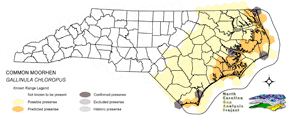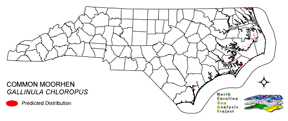
| Taxa: |
| Order: |
| Family: |
| Aves |
| Gruiformes |
| Rallidae |
| NatureServe Global Rank: |
| NatureServe State (NC) Rank: |
| G5 |
| S3B,S3N |
| Federal Status: |
| NC State Status: |
| --- |
| --- |


| Land Unit |
| US Fish & Wildlife Service |
| US Forest Service |
| US National Park Service |
| US Department of Defense |
| NC State Parks |
| NC University System |
| NC Wildlife Res. Com. |
| NC Forest Service |
| NC Div. of Coastal Mgmt. |
| Local Governments |
| Non-Governmental Org. |
| Other Public Lands |
| Private Lands |
| GAP Status 1-2 |
| All Protected Lands |
| Statewide |
| Hectares |
| 20,100.96 |
| 288.00 |
| 8,969.13 |
| 6,263.91 |
| 1,283.40 |
| 147.24 |
| 4,553.91 |
| 6.48 |
| 1,423.80 |
| 9.09 |
| 1,995.03 |
| 61.83 |
| 68,996.97 |
| 32,303.88 |
| 44,557.20 |
| 114,099.75 |
| Acres |
| 49,670.54 |
| 711.66 |
| 22,163.20 |
| 15,478.46 |
| 3,171.35 |
| 363.84 |
| 11,252.95 |
| 16.01 |
| 3,518.29 |
| 22.46 |
| 4,929.83 |
| 152.79 |
| 170,495.19 |
| 79,824.61 |
| 110,103.22 |
| 281,946.57 |
| % of Dist. on |
| Prot. Lands |
| 45.1 % |
| 0.6 % |
| 18.9 % |
| 14.1 % |
| 2.9 % |
| 0.3 % |
| 10.2 % |
| < 0.1 % |
| 3.2 % |
| 4.5 % |
| 4.5 % |
| 0.1 % |
| < 0.1 % |
| 72.5 % |
| ----- |
| ----- |
| % of Dist. on |
| All Lands |
| 17.6 % |
| 0.3 % |
| 7.9 % |
| 5.5 % |
| 1.1 % |
| 0.1 % |
| 4.0 % |
| < 0.1 % |
| 1.2 % |
| < 0.1 % |
| 1.7 % |
| < 0.1 % |
| 60.5 % |
| 28.3 % |
| ----- |
| ----- |
|
Fairly common along the coast and barrier islands (Fussell 1994, Potter et al. 1980). Breeds in areas where proportion of open, fresh or brackish, water and emergent vegetation are about equal (Taylor 1998), such as freshwater ponds, backwaters (Potter et al. 1980), brackish impoundments, lakes (Fussell 1994), canals, and reservoirs (Harrison 1975). Requires more vegetation than does American Coot (Kaufman 1996). Nest is anchored to vegetation over water, or occasionally in a shrub in or near the water (Harrison 1975). NATURE SERVE GLOBAL HABITAT COMMENTS: Freshwater marshes, canals, quiet rivers, lakes, ponds, mangroves, primarily in areas of emergent vegetation and grassy borders; taro patches in Hawaiian Islands. Infrequently flies. Nests usually among marsh plants over water, occasionally in shrub in or near water. Builds nestlike platforms on which to brood young. |
| Code | Name | Description | NC Natural Heritage Program Equivalent |
| 3 | Tidal Marsh | Fresh and brackish tidal marshes, including cord grass, wild rice, sawgrass and needlerush alliances. | Brackish Marsh, Interdune pond, Maritime wet grassland |
| 124 | Maritime Scrubs and Tidal Shrublands | Coastal shrubs including wax-myrtle, swamp rose, alder, yaupon, and greenbriar. | Maritime Shrubs, Salt Shrub |
| 372 | Interdune Herbaceous Wetlands | Dune swales with permanently flooded to intermittently exposed hydrology. Species composition depends on salinity and can include cut grass, spike-rush, mosquito fern, and hornwort. | Interdune Pond, Maritime Wet Grasslands |
| 380 | Coastal Plain Fresh Water Emergent | Emergent vegetation in fresh water seepage bogs, ponds and riverbeds of the coastal plain. Includes alliances dominated by sedges, eelgrass, as well as cane found in unforested cane-brakes. | Small Depression Pond, Sandhill Seep, Floodplain Pool, Unforested Floodplain Canebrake, Riverscour Prairies, Vernal Pools |
| 173 | Coastal Plain Riverbank Shrubs | Shrub dominated riverbanks, commonly dominated by willows and/or alders. | Sand and Mud Bar |
| 239 | Piedmont/Mountain Emergent Vegetation | Emergent vegetation of all wetland hydrologies. Sites would commonly support species such as tussock sedge, rushs, and cattail alliances. | Rocky Bar and Shore (in part) |
| 267 | Riverbank Shrublands | Riverside shrubs with temporarily flooded hydrologies. Found in the both the Mountains and Piedmont. Containing dominants such as smooth alder and a Carolina or black willows. | Sand and Mud Bar |
| 269 | Floodplain Wet Shrublands | Saturated shrublands of the Piedmont, includes buttonbush, swamp-loosestrife, decodon and alders. | Piedmont/mountain Semipermanent Impoundment |
|
Byrd, G. V., and C. F. Zeillemaker. 1981. Ecology of nesting Hawaiian common gallinules at Hanalei, Hawaii. W. Birds 12:105-116.
Eddleman, W. R., F. L. Knopf, B. Meanley, F. A. Reid, and R. Zembal. 1988. Conservation of North American rallids. Wilson Bulletin 100:458-475. Bent, A. C. 1926. Life histories of North American marsh birds. U.S. National Museum Bulletin No. 135. [reprint. 1963. Dover Publications, Inc., New York, New York]. Herkert, J. R., editor. 1992. Endangered and threatened species of Illinois:status and distribution. Vol. 2:Animals. Illinois Endangered Species Protection Board. iv + 142 pp. Fussell, J.O. III. 1994. A birderís guide to coastal North Carolina. Chapel Hill and London: The University of North Carolina Press. Kaufman K. 1996. Lives of North American Birds. Boston, New York: Houghton Mifflin Company. Harrison, H.H. 1975. A field guide to bird's nests in the U.S. east of the Mississippi River. Houghton Mifflin Company, Boston, Massachusetts. 257 p. Harrison, C. 1978. A field guide to the nests, eggs and nestlings of North American birds. Collins, Cleveland, Ohio. Harrison, H.H. 1979. A field guide to western birds' nests. Houghton Mifflin Company, Boston. 279 pp. Potter, E. F., J. F. Parnell, and R. P. Teulings. 1980. Birds of the Carolinas. Univ. North Carolina Press, Chapel Hill. 408 pp. Terres, J.K. 1980. The Audubon Society encyclopedia of North American birds. Alfred A. Knopf, New York. Berger, A.J. 1981. Hawaiian Birdlife. Second Edition. University of Hawaii Press, Honolulu, Hawaii. xv + 260 pp. Scott, J. M., and C. B. Kepler. 1985. Distribution and abundance of Hawaiian native birds:a status report. Pages 43-70 in Temple, S. A. (editor). Bird Conservation 2. University of Wisconsin Press, Madison, Wisconsin. 181 pp. American Ornithologists' Union (AOU), Committee on Classification and Nomenclature. 1983. Check-list of North American Birds. Sixth Edition. American Ornithologists' Union, Allen Press, Inc., Lawrence, Kansas. National Geographic Society (NGS). 1983. Field guide to the birds of North America. National Geographic Society, Washington, D.C. Raffaele, H.A. 1983. A guide to the birds of Puerto Rico and the Virgin Islands. Fondo Educativo Interamericano, San Juan, Puerto Rico. 255 pp. Pratt, H.D., P.L. Bruner, and D.G. Berrett. 1987. A field guide to the birds of Hawaii and the tropical Pacific. Princeton University Press, Princeton, New Jersey. 409 pp. + 45 plates. Stiles, F.G., and A.F. Skutch. 1989. A guide to the birds of Costa Rica. Comstock Publ. Associates, Cornell University Press, Ithaca, New York. 511 pp. Stinson, D. W., M. W. Ritter, and J. D. Reichel. 1991. The Mariana common moorhen:decline of an island endemic. Condor 93:38-43. |
For more information please contact them at:
NC-GAP Analysis Project
Dept. of Zoology, NCSU
Campus Box 7617
Raleigh, NC 27695-7617
(919) 513-2853
www.basic.ncsu.edu/ncgap